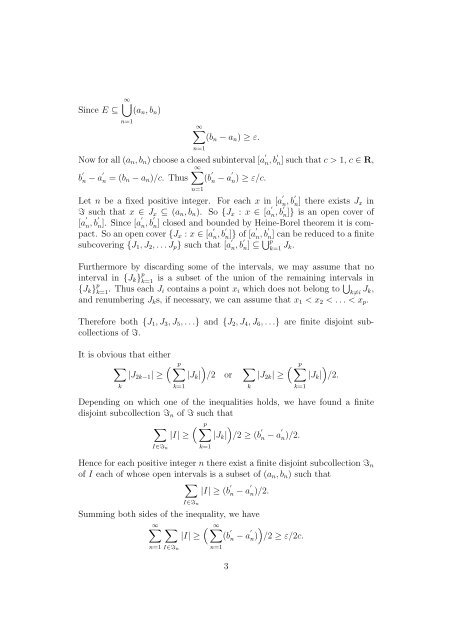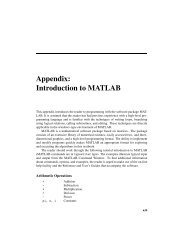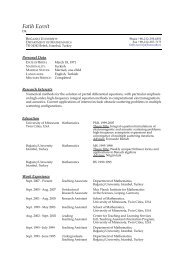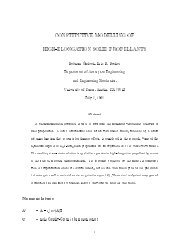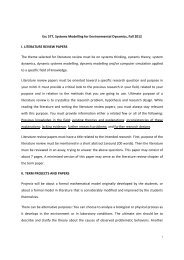an elementary proof of lebesgue's differentiation theorem
an elementary proof of lebesgue's differentiation theorem
an elementary proof of lebesgue's differentiation theorem
Create successful ePaper yourself
Turn your PDF publications into a flip-book with our unique Google optimized e-Paper software.
Since E ⊆∞⋃(a n , b n )n=1∞∑(b n − a n ) ≥ ε.n=1Now for all (a n , b n ) choose a closed subinterval [a ′ n, b ′ n] such that c > 1, c ∈ R,∞∑b ′ n − a ′ n = (b n − a n )/c. Thus (b ′ n − a ′ n) ≥ ε/c.n=1Let n be a fixed positive integer. For each x in [a ′ n, b ′ n] there exists J x inI such that x ∈ J x ⊆ (a n , b n ). So {J x : x ∈ [a ′ n, b ′ n]} is <strong>an</strong> open cover <strong>of</strong>[a ′ n, b ′ n]. Since [a ′ n, b ′ n] closed <strong>an</strong>d bounded by Heine-Borel <strong>theorem</strong> it is compact.So <strong>an</strong> open cover {J x : x ∈ [a ′ n, b ′ n]} <strong>of</strong> [a ′ n, b ′ n] c<strong>an</strong> be reduced to a finitesubcovering {J 1 , J 2 , . . . J p } such that [a ′ n, b ′ n] ⊆ ⋃ pk=1 J k.Furthermore by discarding some <strong>of</strong> the intervals, we may assume that nointerval in {J k } p k=1is a subset <strong>of</strong> the union <strong>of</strong> the remaining intervals in{J k } p k=1 . Thus each J i contains a point x i which does not belong to ⋃ k≠i J k,<strong>an</strong>d renumbering J k s, if necessary, we c<strong>an</strong> assume that x 1 < x 2 < . . . < x p .Therefore both {J 1 , J 3 , J 5 , . . .} <strong>an</strong>d {J 2 , J 4 , J 6 , . . .} are finite disjoint subcollections<strong>of</strong> I.It is obvious that either∑ ( ∑p )|J 2k−1 | ≥ |J k | /2 orkk=1∑ ( ∑p )|J 2k | ≥ |J k | /2.kk=1Depending on which one <strong>of</strong> the inequalities holds, we have found a finitedisjoint subcollection I n <strong>of</strong> I such that∑ ( ∑p )|I| ≥ |J k | /2 ≥ (b ′ n − a ′ n)/2.I∈I nk=1Hence for each positive integer n there exist a finite disjoint subcollection I n<strong>of</strong> I each <strong>of</strong> whose open intervals is a subset <strong>of</strong> (a n , b n ) such that∑I∈I n|I| ≥ (b ′ n − a ′ n)/2.Summing both sides <strong>of</strong> the inequality, we have∞∑ ∑ ( ∑ ∞ )|I| ≥ (b ′ n − a ′ n) /2 ≥ ε/2c.n=1 I∈I n n=13


